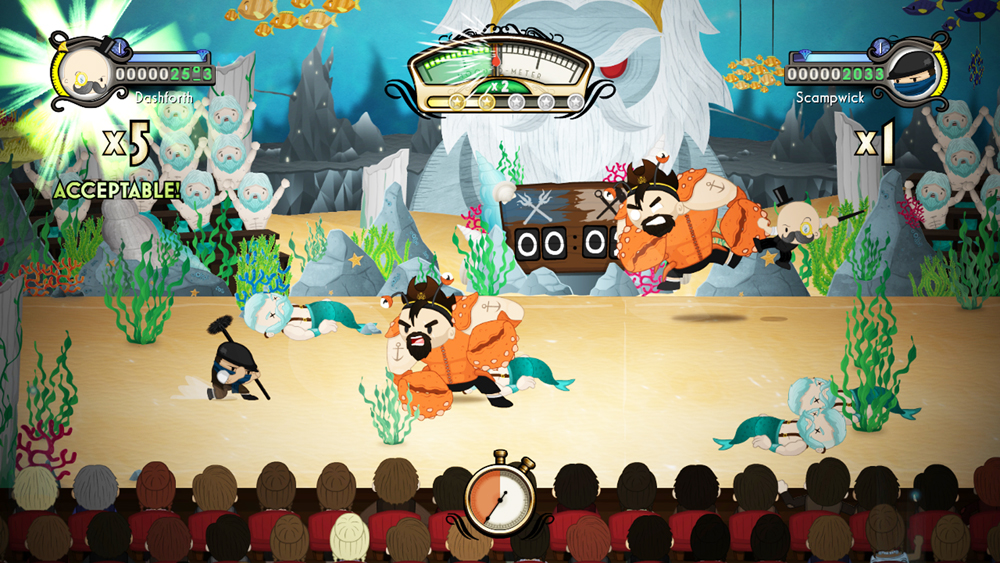Foul Play is a theater inspired side-scrolling beat ‘em up game that emphasizes style over button mashing. The game’s combo and charm systems encourage players to react quickly and to strive for perfection. It’s a shame that the game itself can’t reach the lofty heights it demands of the players. Foul Play ends up feeling like a game more about the style and less about the substance.
In Foul Play you are Baron Dashforth, a gentlemen demonologist who has rented a theater to tell the story of his last two decades fighting the minions of the underworld. With the help of your Cockney sidekick Scampwick, you must keep your audience entertained through your recollections. In Foul Play, your performance is determined by the number of combos you are able to chain together. The better you are at sustaining combos, the happier the crowd is. And you always want to have a happy crowd, because the crowd’s temperament determines your longevity in the game. Perform poorly and it’s curtains. Literally.
The game runs within the theater motif to its fullest extent. The environments you fight in take the form of sets, deployed accordingly as scenes shift. Enemies are actors in costume, occasionally pulled offstage via a comically large cane upon defeat. An audience cheers as you rack up combos and boos when you’re getting pummeled. Everything onstage is alive with motion and complemented by a gorgeous, detailed art style. Unfortunately, the art in Foul Play is the game’s high point.
Where the art shines, the sound design in Foul Play takes a back seat. The music and sound effects in the game come off sounding flat. I experienced several stretches where the music quieted for what felt like too long, or an onscreen action wasn’t accompanied by a sound effect. There are inspired moments in Foul Play’s sound, such as when the crowd chants your name or a robot enemy speaks, but they’re rare.
There is a dullness that infects Foul Play that can largely be attributed to the game’s repetitious combat. The combat is your standard beat ‘em up affair of alternating light and heavy attacks. While more advanced techniques and moves are introduced later in the game, they often take time to charge or are unresponsive, thus going against what feels like the true goal of the game: Foul Play wants you to get from enemy to enemy as quickly as you can so that you can maintain your combo. If you’re hit by an enemy or go too long without hitting an enemy, your combo dies.
Combos are critical to not only staying alive, but completing challenges. The only way to unlock upgrades, called Charms, in Foul Play, is by completing challenges, and there are three challenges per level. Complete all three and you gain access to a new Charm that can be equipped for modifiers and stat bonuses. Challenges often come in the form of “maintain a combo for a certain number of hits” or “perform a perfect scene,” meaning that you maintain a combo for the duration of the scene. In my initial play through I unlocked a single, underwhelming Charm. After a while I stopped worrying about them, as their absence didn’t seem to be negatively affecting my play.
Foul Play is clearly built with co-op play in mind, as a second player can take control of Scampwick and join the fight. It is an odd design choice, then, that a second player cannot jump in or out mid-game. For a second player to join, the first player must exit the current level and retreat to main menu. Perhaps it’s a minor gripe, but if beat ‘em up arcade cabinets from twenty years ago can figure out jump-in co-op, I find myself wondering, why can’t Foul Play?
While the art in Foul Play is gorgeous, there are times when it feels like a bit too much. Parrying is a critical skill in the game. If you don’t learn how to do it early on, you’re going to have a bad time. A parry is performed by tapping the “B” button on an Xbox 360 controller just as the enemy is about to attack, which is a telegraphed by lightning bolts over an enemy’s head. In later stages, where larger enemies and busy backgrounds obscure that visual cue, it’s possible to be boxed into a corner and lose very nearly all of your health in a few short seconds. In situations like this, I found myself just hammering on the parry button and sending enemies flying across the screen. It was a valid tactic, as it worked, but I couldn’t help but feel like I was cheesing the game.
The beat ‘em up genre is one that has been done to death. Frankly, I’m surprised they still exist. In order for a modern beat ‘em up to stand out, it has to do something new, something refreshing. Foul Play should be applauded for doing just that, and while several recent games have wowed me in their ingenuity, Foul Play just isn’t one of them. The art and the combo system are a good first step, but repetitious combat, the lackluster sound design and the complete absence of mid-game local cooperative drop-in makes Foul Play rather disappointing.






